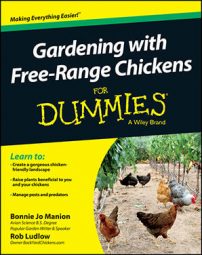Mature trees, by their very height and presence in a landscape setting, provide shade for your chickens, and also offer visibility shelter from sky predators, such as hawks, owls, and other birds of prey. Additional planting of lower protective shrubs among your trees adds to the layering effect and plant density that shelters chickens.
Trees come in many sizes, from small and ornamental to massive and well-structured. Trees can be evergreen or deciduous. In a garden with free-ranging chickens, you want to choose trees that provide shelter, canopy shade, and dappled sunlight for other lower garden landscape.
Shrubs play a very important role in chicken gardens, because chickens like to spend time under them. Shrubs that protect and shelter chickens are usually, but not always, evergreen and can weep and drape to ground level. Chickens can actually conceal themselves under large shrubs, and even relax with dust baths under them. Shrubs can be very showy, ornamental, and a good fit with your chosen garden style.
Suggestions for chicken-sheltering trees and shrubs
Here are suggestions for planting trees and shrubs that protect in a chicken garden.
Trees are most practical for shelter in a large garden landscape space.
Consider planting native trees and shrubs in your garden landscape because they’re naturally suited to your climate, and generally are low maintenance, requiring less water, fertilization, and pruning.
Carefully consider mature sizes of trees and shrubs, and how they fit in your intended space.
Trees and shrubs that have four-season interest easily create a beautiful garden landscape throughout the year.
Research what you’re planting in your garden landscape isn’t poisonous and extremely toxic to chickens.
Tree examples that shelter
The following trees offer shelter to your chickens:
Birch: Betula. Deciduous trees. Zones vary by species. Striking bark.
Buckeye and horse-chestnut: Aesculus. Deciduous trees or shrubs. Zones vary by species.
Elm: Ulmus. Deciduous or evergreen trees. Zones can vary by species. Beautiful shade trees; can be prone to disease.
Magnolia: Magnolia. Deciduous and evergreen trees and shrubs. Zones vary by species. Magnificent ornamental trees.
Maple: Acer selections. Zones 3–9. Many varieties. Can reach massive size. Striking foliage colors.
Olive: Olea europaea. Evergreen trees. Slow growing. Silvery gray foliage. Fruit and fruitless varieties.
Pine: Pinus. Evergreen trees. Zones vary by region. Many varieties with individual characteristics. Can be massive in size.
Serviceberry or Juneberry: Amelanchier. Deciduous shrubs or small trees. Berries. Amelanchier x grandiflora “Autumn Brilliance” is a stunning four-season tree.
Spruce: Picea. Evergreen trees. Zones vary by species. Large and dwarf varieties. Can also be grown in a container.
Sycamore or plane: Platanus. Deciduous trees. Zones vary by species. Tree varieties can vary in size. Can be massive in size. Known for their striking dappled bark.
Shrub examples that shelter
Consider the following shrubs when you want to add shelter to your chicken garden:
Barberry: Berberis darwinii. Evergreen shrub. Zones 5-9. Very showy evergreen with fountain like growth. Dark blue edible berries. Can be invasive in some areas.
California wild lilac: Ceanothus. Evergreen shrubs or ground cover. Zones 5–9. Many varieties. Hardy California native, but also found in other parts of the United States. Hardy, drought tolerant. Beautiful shades of blue flowers in late winter and early spring.
Camellia: Camellia, Evergreen shrubs or trees. Typically zones 4–9. Prefer shade. Beautiful showy flowers.
Juniper: Juniperus. Evergreen shrubs and trees. Zones vary by species. Very versatile easy-to-grow plant. Comes in many forms and shades of foliage. Junipers in a landscape are beautiful and hardworking.
Lilac: Syringa selections. Deciduous shrubs. Zones vary by species. Many pluses with this shrub with beautiful flowers, fragrance, and foliage.
New Jersey tea: Ceanothus americanus. Deciduous shrubs. Zones 4–8. Compact, low shrubs up to three feet tall. Easy to grow and drought tolerant. Fragrant, sweet flowers. A native shrub that can naturalize. A great example of a nitrogen-fixing shrub.
Rockrose: Cistus. Evergreen shrubs. Zones 8–11. Drought tolerant. Showy flowers.
Plumbago: Ceratostigma, Evergreen shrub and ground cover. Zones 9–11. Blooms spring through early winter.
Siberian Pea Shrub: Caragana arborescens. Deciduous shrub. Zones 2–9. A great ferny, weeping shrub which tolerates dry and cold conditions. It has small yellow fragrant flowers and seedpods chickens like. It is a good example of a nitrogen-fixing shrub.
Viburnum: Viburnum burkwoodii. Semi-evergreen shrubs. Zones 5–8. Many pluses. Fragrant, showy flowers. Good for windbreak and privacy screening.

